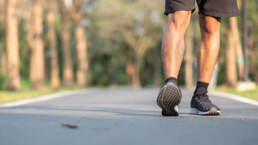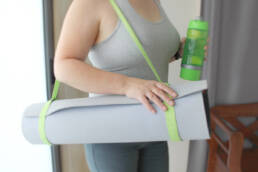It’s common knowledge: exercise is good for the mind and body. Specifically, exercise may help to regulate your appetite[i] and weight[ii], lower your risk of cardiovascular disease and some cancers[iii], and mediate symptoms of depression[iv], anxiety[v], or insomnia[vi]. But how much exercise should you be getting?
The Centers for Disease Control and Prevention recommends that adults get at least two and a half hours of moderate physical activity or 75 minutes of vigorous physical activity each week. It may be difficult to tease apart moderate and vigorous activity. Moderate physical activity makes you move a bit more than normal activity but will not leave you panting for breathe. Examples of moderate physical activity include mowing the lawn, raking leaves, swimming, and brisk walking. On the other hand, vigorous physical activity significantly increases your heart rate and includes activities like running, jogging, dancing, and jump roping. In addition to aerobic activity, adults should also aim to work out with activities that aim to strengthen and build muscle.
Unfortunately, being aware of the recommendations doesn’t make it any easier to fit room in your schedule for an exercise routine. But luckily, there are some easy ways to squeeze exercise in your life. If you find yourself low on time, you can incorporate exercise into your daily activities to reach your weekly minutes. You may not even have to stray far from your couch or desk to boost your physical activity.
- Opt for the Stairs: Using the stairs is an easy way to temporarily boost your heart rate. Plus, climbing the stairs may be just as fast, if not quicker, then waiting for and taking the elevator.
- Park Far Away: The extra minute or two it takes to walk from the end of the parking lot to the store entrance can quickly add up to make you more physically active. Plus, parking further away will save you the time and frustration associated with finding that perfect spot.
- Take a Walk with your Dog (or Child!): Including loved ones into your physical activity routine will help both of you stay physically active and make your work-out more enjoyable.
- Maintain Realistic Goals: While a big goal may temporarily hype you up for exercise, it may be difficult to maintain. So instead, choose realistic goals. Aim to lose an extra five pounds, strive to run a full mile, or sign up for a 5K in your community.
- Walk the Mall: Few people can motivate themselves to walk or run outside when it is snowy, icy, or rainy. For these occasions, take a brisk walk at your local mall instead.
- Reward Yourself with Goals: Keep yourself motivated with rewards for diligent exercise. But instead of treating yourself to dessert or a week of rest, give yourself a prize like sneakers or athletic wear that will help you stay on track with longer-term goals.
- Trade in Your Chair: Swapping your rolling chair for an exercise ball will help you strengthen your core and abdominal muscles.
By incorporating exercise into your daily life, you can easily up your physical activity level. But when starting a physical activity regimen, ease your way into it and stretch thoroughly before working out to avoid aches or injury. In addition, if you have a pre-existing medical condition, first speak with your doctor to make sure you take all precautions to keep yourself safe and healthy. While it may take time to establish an exercise routine or develop physical activity habits, remember that some physical activity is better than nothing.
Did you enjoy this post? Feel free to share it with people that you love and care about. As always, we provide COMPLIMENTARY CONSULTATIONS to discuss your individual case and determine if we are a good fit to help you improve your heath.
[i] Martins, C., Morgan, L., & Truby, H. (2008). A review of the effects of exercise on appetite regulation: an obesity perspective. International Journal of Obesity, 32(9), 1337-1347.
[ii] Fogelholm, M., & Kukkonen‐Harjula, K. (2000). Does physical activity prevent weight gain–a systematic review. Obesity reviews, 1(2), 95-111.
[iii] Warburton, D. E., Nicol, C. W., & Bredin, S. S. (2006). Health benefits of physical activity: the evidence. Canadian medical association journal, 174(6), 801-809.
[iv] Ströhle, A. (2009). Physical activity, exercise, depression and anxiety disorders. Journal of neural transmission, 116(6), 777-784.
[v] Ströhle, A. (2009). Physical activity, exercise, depression and anxiety disorders. Journal of neural transmission, 116(6), 777-784.
[vi] Reid, K. J., Baron, K. G., Lu, B., Naylor, E., Wolfe, L., & Zee, P. C. (2010). Aerobic exercise improves self-reported sleep and quality of life in older adults with insomnia. Sleep medicine, 11(9), 934-940.

Ready for an expert opinion? Get in touch today!
Chiropractic care in Redmond offers a holistic approach to health and well-being. Through gentle adjustments, personalized treatment plans, and patient education, chiropractors aim to improve spinal alignment, relieve pain, enhance performance, and promote overall wellness.
Like this article? Spread the word!
Related Posts
April 5, 2022
Why Seeing a Chiropractor After a Car Accident Is a Smart Decision
Chiropractors report that many car accidents result in injuries that can be helped by…
August 29, 2018
Top 8 Benefits of Strength Training Workouts
Many of us struggle to find the time and motivation to get the proper amount of exercise…





